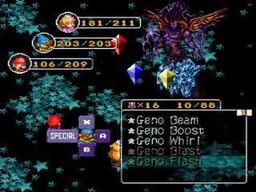The wiki is lacking in content. You can help by creating a new article. See the to do list for more ways you can help.
Difference between revisions of "List of references to Final Fantasy in other media"
| Line 18: | Line 18: | ||
===''Bug Fables: The Everlasting Sapling''=== | ===''Bug Fables: The Everlasting Sapling''=== | ||
*Two characters in the Termite Kingdom Pier are named after [[Biggs]] and [[Wedge]], respectively. <ref>''Bug Fables: The Art of Bugaria''<ref> | *Two characters in the Termite Kingdom Pier are named after [[Biggs]] and [[Wedge]], respectively. <ref>''Bug Fables: The Art of Bugaria''</ref> | ||
== Television shows == | == Television shows == | ||
| Line 28: | Line 28: | ||
==References== | ==References== | ||
<references/> | |||
{{Nav Main Pages}} | {{Nav Main Pages}} | ||
[[Category:Lists]] | [[Category:Lists]] | ||
Revision as of 23:07, November 18, 2022
This is a list games, web comics, anime, western animation and more that have been referenced in a Final Fantasy game.
Games
Super Mario RPG: Legend of the Seven Stars
Super Mario RPG: Legend of the Seven Stars was developed by Square. There are several references to the Final Fantasy series:
- An optional mini-boss, Culex, is an allusion to the Final Fantasy series. His overworld sprite resembles enemy designs in the 2D Final Fantasy titles, and these sprites do not have as complex animations and frames, reminiscent of early Final Fantasy games. The music heard during the Culex battle is a remix of "Battle 2", the boss battle theme for Final Fantasy IV. The music that plays when he is defeated is a rearrangement of the victory music present throughout the Final Fantasy series, and the ending conversation is an arrangement of the Final Fantasy "Prelude". Culex's English name is the Latin word for "mosquito", referencing Golbez, whose name is taken from a type of fly.
- In the Japanese version, Culex claims to be a timeless overlord made of pure evil. As a two-dimensional being, he is perplexed by the isometric forms of Mario's party, so he demands a fight to try and understand them. Upon defeat, he recognizes the party's strength and positive energy, and he and his pocket dimension disappear until the day he finally gains the solidity of the third dimension. In the English version, Culex's dialogue and backstory are completely rewritten: he is said to be a "Dark Knight of Vanda" sent by the Dark Mage, but his plans came to a halt after discovering that Mario's world is uninhabitable to him and his kind. All Final Fantasy games released before Super Mario RPG: Legend of the Seven Stars were 2D, which likely inspired his dialogue for both versions.
- The Japanese version of the game includes direct references to two villains of the Final Fantasy series as possible answers for the Dr. Topper quiz: "Exdeath" is an answer for the first monster seen in the Pipe Vault (instead of Chompweed), and "Kefka" is an answer for the ultimate enemy in the adventure (instead of Goomba).
- The music for the Mushroom Kingdom is similar to the castle theme of Final Fantasy V.
- The Wind Crystal, Water Crystal, Fire Crystal, and Earth Crystal appear alongside Culex during his boss battle.
- Flower Points are the Mario-themed version of Magic Points.
- The Super Mario RPG: Legend of the Seven Stars enemy Bahamutt, shares its name with Bahamut from the Final Fantasy series, but with an extra 't'. Despite similar names, the characters are entirely different.
- In Final Fantasy VI, there is an unused enemy known as CzarDragon with an unfinished battle script, sharing a name with the Czar Dragon enemy in Super Mario RPG: Legend of the Seven Stars. It was brought back as the superboss Kaiser Dragon (the Japanese name of both dragons) in Final Fantasy VI Advance, though the original Kaiser Dragon still exists in the game data.
- Four members of the Smithy Gang each carried an element, similar to the fiends from the Final Fantasy games. Mack has a fire element, Bowyer has a lightning element, Yardovich has a water element, and the Axem Rangers have a "Jump" element.
- The enemy Zombone, which is the second form of the Czar Dragon, shares a name with the Zombie Dragon, whose name was localized as Zombone in Final Fantasy III for the Super Nintendo Entertainment System. In Final Fantasy VI Advance, the name was changed to Zombie Dragon.
Bug Fables: The Everlasting Sapling
Television shows
Robot Chicken
In the episode "Rodigitti" of Robot Chicken, Cloud, Tifa, Yuffie, Barret, and Aerith were cast as workers and Sephiroth was cast as the manager of a fast food restaurant. Cloud (using his Buster Sword as a kitchen knife) and Barret (with his Gun-Arm replaced as a spatula) are chefs, Aerith works the register, Tifa and Yuffie alert the others to the beginning of the restaurant's rush hour, and Sephiroth (accompanied by a full-orchestra parody of his One-Winged Angel theme song, in which the "Sephiroth!" choral lyric is replaced with "Hamburger!") is the manager who suddenly appears at the door and forces Cloud (who has Lakers tickets) to work on Saturday. They battle, Sephiroth uses an attack called "Unpaid Overtime!". Cloud uses "Ultimate" which causes a giant meteor to smash into the restaurant, destroying it.
Web comics
- Final Fantasy serves as the bases for 8-Bit Theater. The comic follows the basic plot, albeit with artistic license and creative liberties given to help flesh out the minor details. It ran for 1224 issues and an epilogue.
References
- ^ Bug Fables: The Art of Bugaria
